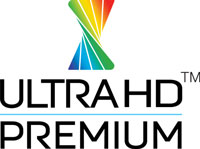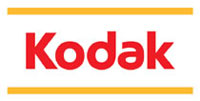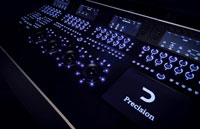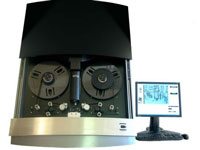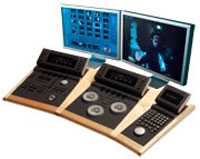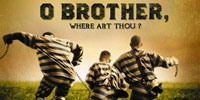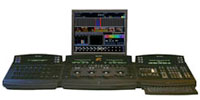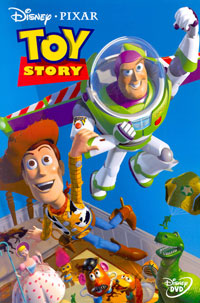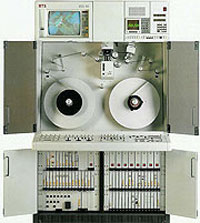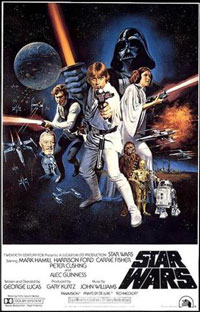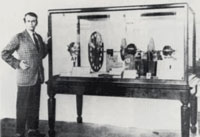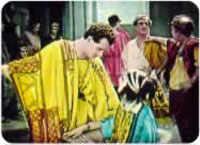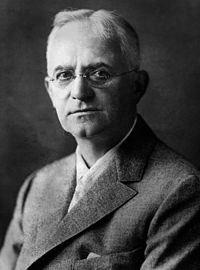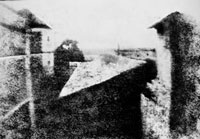2017
Sony announce support for
Dolby Vision HDR in their consumer products. They join LG, Leowe and Vizio. HLG and HDR10 are the cheaper less featured HDR alternatives.
2016
According to World TV Production, Netflix and Amazon have more than doubled their annual expenditure on programming, reaching $7.5 billion in 2015, and eclipsing CBS, HBO and Turner in spending, as well as several countries, including South Korea and Australia. Both companies are delivering UHD (4k) and HDR content.
2016
UHD Premium logo, certification and licensing announced by the UHD Alliance. The UHD Premium specification insists on 10 bit HDR (rec 2084) and Wide Color Gamut (rec 2020)
2015
Disney's "Tomorrowland" is the first film to be projected in Dolby Vision with HDR laser projection.
I work with Dolby as HDR Colorist Consultant on a 4000 nit Pulsar in London.
2015
UHD Alliance is formed to agree HD and better standards between studios, manufacturers and distributers.
Digital Vision is acquired by its management team who promise to preserve the heritage of the 26 year old company.
Dolby acquires Doremi Labs, a key player in digital cinema playback servers. Dolby later announces Dolby Cinema plans. Dolby Cinema will feature HDR laser projection, Dolby Atmos sound and large format screens. The best technology has to offer and the first real competition to IMAX.
AMPAS announces the release of ACES version 1.0. After two years of use in beta there is much excitement and high expectations.
2014
Interstellar is shot on 65mm IMAX film and presented as 70mm film projection at selected cinemas. This may well be the last film to be shot and finished for 70mm. The experience of a life time!
Yes, of course I saw it. First public show 6 November 2014. Just brilliant.
2014
IBC. Christie demonstrate their Six Primary laser projector to show "Life of Pi" and Dawn of the Apes" in Dolby 3D, at 14 ft lamberts on a white screen, complete with Dolby Atmos sound.
Dolby Vision also made a big impression. The prototype HDR monitor can peak at 4000 nits - 40 times brighter than rec 709.
BMD buy Eyeon and its Fusion vfx software. Within 2 months there is a free version.
I managed to get in to Dawn of the Apes. Well worth the wait. Does it get any better? Actually yes - see the Interstellar entry :-)
2014
Digital Vision responds to what they refer to as the "destructive and destabilising commoditisation" of the market by slashing their prices. Their flagship Film Master software now costs under 5000 euros and supports Tangent panels as well as their own Precision set. How much of the Resolve market will make the change? Watch this space :-)
2014
Blackmagic Design announce their new 35mm and 16mm film scanner based on Cintel Ditto and Image Mill technology. The new scanner has a small footprint and uses Thunderbolt 2 to transfer 35mm at 30fps in UHD resolution. And it costs under $30,000!
2014
Quantel maker of Pablo buys Snell, maker of Alchemist.
2014
NHK transmit 8K Super Hi Vision for the first time in an experiment. The 33 million pixels per frame broadcast is received succesfully 27 km away.
2014
Paramount releases The Wolf of Wall Streetin digital format only. It is the first Hollywood Studio to leave film behind entirely. None of their future releases will be on film print.
Only 8% of US cinemas do not have digital projection kit.
2013
ACES version 0.2.2 is released and includes a revised RRT and updated ODTs as well as introducing ACESlog, ACESproxy and a way to reverse the ODT, RRT transforms.
2013
Deluxe shut the last film lab in Australia in April. Park Road close their New Zealand Lab in June. There are no longer any labs in New Zealand or Australia. Kofic shut the last lab in Korea too. The nearest film lab to Australia is now Kantana in Thailand. All three labs in South Africa are closed. There are similar stories around the world this is truly the end of an era. Film R.I.P.
2013
Fuji Film announced on April 2, 2013 that they have stopped production of most Motion Picture Film products. As a result b/w and color negative, positive and intermediate stocks are discontinued. Digital workflow products such as Recording film for Digital Separation [ETERNA-RDS] for long-term archiving will continue.
2012
Cintel International liquidated. BMD buy its IP and product range including scanners, telecines and noise reducers.
2012
ACES workflows and transforms are ready for mainstream use.
Nucoda Film Master and Da Vinci Resolve amongst others introduce the necessary color transforms for ACES work. The
Academy of Motion Picture Arts and Sciences wins an engineering Emmy in the same year.
2012
Peter Jackson shoots The Hobbit on Red (5k) cameras in stereo at 48fps. That's about 16 times the storage of a regular 2k production.
2012
4K and 8K UHDTV formats - Ultra High Definition Television - announced in May 2012 by ITU-R Working party 6C. They are constructed as multiples of 4 and 16 times the 1080p1920 format in ITU-R Rec. 709 and allow up to 120 pictures/second.
2012
Kodak commences voluntary Chapter 11, financed by Citigroup. The greatest pioneer of both film and digital imaging plans to sell 1100 of its patents to finance a new future. Kodak engineers were awarded 19,576 US patents between 1900 and 1999.
2011
Sony show 24 inch OLED professional monitors and announce the F65 camera
2011
The Dolby Professional Monitor, although expensive is accepted as the EBU reference display. Dolby Laboratories win an engineering Emmy for it in the 2012 awards
2011
Adobe buys Iridas. The deal includes the rights to the Speedgrade family of products as well as the development team. Adobe Premiere grows in popularity as well as features.
2011
THX buy cineSpace color management software. ICA becomes a training partner to THX.
2011
Encore are the first to use the new IIF ACES workflow for the television series 2 of Justified
2011
Apple update Final Cut Studio to FCPX to the disappointmet of many professionals. Biggest shock is that Color is dropped from the package, and is no longer available.
2011
Image Systems buys Digital Vision, and the new Precision panels are released.
2011
Blackmagic Design release DaVinci Resolve 8.0 with new curve tools and a multi track timeline. They also launch Resolve Lite, a free version with few limitations.
2010
Autodesk release Flame Premium that bundles Flame, Smoke and Lustre all in one package.
2010
Digital Vision reveal the Precision control panels. The first color grading control surface to include touch panels and thumbsticks. They also introduce Clarity a new noise reducer that works as well on digital camera noise as film grain
I had been consulting on the new panel design for over 3 years. It was fantastic to see so many ideas make it to the final design.
2010
Blackmagic Design announces DaVinci Resolve 7.0 for Mac OSX and a price of $995. Until now DaVinci Resolve systems cost from $200,000 to over $800,000.
2009
Avatar becomes the fastest film to take one billion dollars at the box office. It took just 17 days.
2009
Blackmagic Design buy da Vinci Systems, which was in danger of closing down.
2008
Digital Vision show stereoscopic 3D monitoring and Turbine, a background render booster that uses Blades, for Film Master.
They also augment Phoenix toolsets for restoration projects
2008
Quantel show new panels for Pablo
2008
da Vinci show new Impressario panels for Resolve
2007
Color Transform Language (CTL) published as SMPTE RDD-15. CTL plays a crucial part in developing ACES.
2007
Apple introduces Color (formerly Silicon Color Final Touch) as part of the Final Cut Studio 2.
2007
Quantel show Pablo with stereoscopic 3D toolset
2007
2X quad core PCs become available
2006
4X dual core and 8X dual core PCs become available from Boxx and others
2005
Cintel launches diTTo - a low cost 2K data scanner, with a 3K native sensor
2005
Quantel launches Pablo DI grading system
2005
Digital Vision buys Nucoda, developers of Film Master. Digital Vision Optics (DVO) launched, providing software version of DVNR noise and dust tools.
2005
Autodesk buys Lustre from Colorfront.
2004
Cintel announces GRACE is now available as an external film grain reducer.
2004
Cintel launches dataMill fast data scanner based on Millennium 2 technology
2004
50 leading technologists cooperate with the Science and Technology Councilof the Academy to begin work on an architecture and supporting tools for digital motion picture production, mastering and archiving. This is the begining of ACES.
2004
Spider-Man 2 – The first digital intermediate on a new Hollywood film to be done entirely at 4K resolution
2004
The Polar Express is released as IMAX 3D, which earns 14 times as much as the 2D version and causes renewed interest in producing 3D feature fims.
2004
The Aviator – Martin Scorcese forced to use DI to recreate the Technicolor process that was de-commissioned in 2002
2003
Quantel announce QColor, an in context grading solution for the IQ platform
2003
da Vinci announces Resolve software color corrector.
2003
Cintel launches GRACE, an internal Film Grain Reducer option for C-Reality and DSX machines
2003
Cintel launches updated Millennium 2, a CRT based 4K data-cine.
2003
Thomson launches Spirit 4k datacine.
2003
Autodesk licenses Lustre (previously 5D Colossus) by Colorfront.
2003
Nucoda Data Conform used on Harry Potter.
2003
ILM release OpenEXR to the public.
2003
Silicon Color formed to develop Final Touch, which later is bought by Apple and becomes Color in Final Cut Studio 2.
2003
Apple FCP introduces 3 way color tool.
2003
Sony HDCam SR vtr launched.
2002
5D ceases trading, Colorfront continues.
2002
The fifth Star Wars film Attack of the Clones, is the first major Hollywood film shot entirely on digital (video) cameras.
2002
Cintel acquires the assets of competitor Innovation TK including the Millennium data-cine.
2002
Cintel launches DSX - the worlds first 4K data-cine, which includes Oliver, formerly OSCAR optical dust and scratch removal. Cintel International acquires the assets of competitor Innovation TK including the Millennium data-cine.
2002
da Vinci adds Colorist Toolbox for all 2K systems.
2002
da Vinci 2K Plus color corrector introduced. It is controlled by a Linux computer and has significantly better Primaries and secondaries.
da Vinci fixed many of the flaws in the 2k. Now the best hardware color corrector that will ever be built.
2002
Thomson, formerly Philips, formerly BTS, formerly Bosch, launches Viper electronic camera with 4:4:4 log output.
2001
Cintel, formerly Rank Cintel, launches OSCAR a revolutionary optical dust and scratch removal system for their telecines. The product is later renamed OLIVER after complaints from the OSCAR awards people.
2001
5D launches Colossus software color correction licensed from Colorfront after it has been used to grade Lord of the Rings part 1, aka The Fellowship of the Ring
This was the first time hardware colorists realized that software was coming...
2001
da Vinci introduces PowerGrade (a memory library) and Gallery (a built in still store)
This was all my idea, and I later got a similar feature into Film Master.
2001
The year that DVD sales overtake VHS sales.
2000
O Brother, Where Art Thou? – The first time a digital intermediate was used on the entirety of a first-run Hollywood film which otherwise had very few visual effects. The work was done in Los Angeles by Cinesite utilizing a Spirit Datacine for scanning at 2K resolution, a Pandora MegaDef to adjust the color and a Kodak Lightning II recorder to output to film.
2000
Quantel launch the IQ platform, a hardware system for editing, compositing and grading SD, HD and digital film.
2000
Philips announces Voodoo VTR.
2000
da Vinci adds Defocus options to 2K systems.
1999
Sony launch the Vialta Telecine. Multi format (16 mm, S16 mm, 35 mm, S 35 mm), multi standard (601 SDTV, HDTV and data) field array ccd device with internal primary color correction. Formerly known as FVS 1000. Ceased production around 2004.
1999
Philips, formerly BTS, formerly Bosch, introduces Specter as the first virtual telecine.
1999
da Vinci announces Power Tiers for 2K systems
Read my Layer It article to learn more about Tiers, Channels and Layers.
1999
ILM develop OpenEXR, a multi channel 16 bit half float file format
1998
da Vinci Academy formed when I join them in Florida.
I had been doing da Vinci training for many years, and in 1998 they invited me to Florida to start up a dedicated colorist training facility.
1998
da Vinci introduces the
2Kcolor corrector for SD, HD and data.It is controlled by an SGI O2 computer.
1998
Avid acquires Softimage Inc. from Microsoft Corporation. Avid also delivers Symphony, a nonlinear noncompressed editing system for Windows NT, priced at $150,000 for a basic turnkey system. Symphony was essentially a noncompressed version of Media Composer and included color correction.
1998
Pleasantville – The first time the majority of a new feature film was scanned, processed, and recorded digitally. The black-and-white meets color world portrayed in the movie was filmed entirely in color and selectively desaturated and contrast adjusted digitally.
1997
Kodak discontinues Cineon. However the file format .cin and its derivative .dpx continue to be used as the most common format for digital intermediate systems.
1996
Philips in collaboration with Kodak introduce the Spirit Datacine for SD, HD and data
Up until now Rank Cintel had monopolized commercial facilities. Spirit changed all that.
1996
sRGB is created jointly by HP and Microsoft for use on monitors, printers and the internet.
sRGB uses the
ITU-R BT.709 primariesbut has a non linear gamma and therefore looks different from rec709.
1997
Rank Cintel Ltd. introduces URSA Diamond.
1995
Pixar release Toy Story, the worlds first computer animated feature and is the highest grossing film of the year. Pixar also goes public and is the largest IPO of the year.
1995
da Vinci launches DUI interface for 888 color systems. The upgrade replaces the on board CPU with an SGI Indy computer. The Indy later became obsolete and was replaced by the SGI O2, which was affectionately known as the Toaster.
I was a beta tester for the DUI while at Online Video in Zurich.
1994
BTS, formerly Bosch, introduces flh 1000 HD a revolutionary new High Definition CCD telecine that will become the Spirit.
1994
da Vinci wholly aquire Time Logic which make the best telecine to tape controler on the market. The product is known as the TLC (Time Logic Controller) and is integrated into the new DUI interface
1993
Quantel launch Domino a complete digital film in, film out editing and effects system. It is criticized for being only 8 bits but is an affordable alternative to Kodaks Cineon.
1993
ITU rec BT 709 first version approved for HDTV standard.
1993
Snow White and the Seven Dwarfs – First film to be entirely scanned to digital files, manipulated, and recorded back to film. The restoration project was done entirely at 4K resolution and 10-bit color depth using the new Cineon system to digitally remove dirt and scratches and restore faded colors.
1993
Kodak introduce Cineon for 2k and 4k digital intermediate work. The system includes a film scanner, workstation and film recorder.
1993
Rank Cintel Mk III HD high definition telecine goes into service at Universal Studios in Hollywood.
1993
Rank Cintel Ltd. introduces URSA Gold.
I worked on a prototype Ursa Gold with guru Paul Grace at Rushes, London
1993
Sony Digital Betacam VTR launched.
1992
Rob Lingelbach starts the
Telecine Internet Group (
TIG), a mailing list dedicated to active colorists and telecine engineers. The TIG is still probably the best resource available for colorists, those who wish to be colorists and those who want to be colorists
1992
da Vinci introduces Power Windows and Custom Curves
Soft-edged windows! How on earth did we get by without them?
1992
EFilm used their proprietary film recording technology on Disney's Honey I Blew up the Kids.
1991
Bosch launches the FDL 90 CCD line array telecine.
1991
da Vinci launches 888 digital color corrector for SD video.
Not the first digital color corrector in the world (that was Copernicus) but it was my first.
1991
Apple launches Quicktime.
1990
Photoshop 1.0 is released
The Rescuers Down Under – First complete feature-length film to be recorded to film from digital files; in this case animation assembled on computers.
1989
da Vinci introduces Kilovectors
This was a major feature set back then, everybody else was limited to six secondaries.
1989
Avid introduce Media Composer, their first editing system.
1989
The all-digital Rank Cintel Ltd URSA telecine makes its first appearance, at Montreux, with simultaneous launches in New York and Los Angeles. Rank Cintel Ltd tried unsuccesfully to force customers to use their purpose built ARCAS grading system to control it. ARCAS was never popular and failed to rival the big two hardware telecine controlers from da Vinci and Pandora.
I moved to SVC Ltd. London to work on the second URSA to be delivered. This was truly a major advance in telecine technology. The Ursa was probably the first telecine that transferred negative and inter-positive films without difficulty.
1988
Digital Vision formed.
They revolutionizedreal-time noise reduction. Many of us believe they have always been the best.
1987
Rank Cintel Ltd launches Digiscan 4:2:2 to give digital outputs from the Mk III telecine.
1987
Avid Technology Inc formed by William J. Warner with an idea for non linear editing.
1987
Sony D1 uncompressed digital component vtr introduced
The begining of uncompressed digital!
1986
Imax starts showing non fiction films in 3D.
1985
Kodak invent OLED (Organic Light-Emitting Diode) technology.
1984
da Vinci Classic color corrector launched
... and my secoond color corrector
1983
Sony Betacam VTR launched.
1983
Amigo, a highly sophisticated controller and pre-programmer for the Mk III is launched.
1980
VTA develop the Wiz color corrector, which became da Vinci Classic.
1979
Bosche launches fdl 60 CCD line array telecine.
The telecine I trained on back at Telecine Ltd. in London.
1978
Rank Cintel Ltd introduces TOPSY, a remote control programming system the Mk III telecine.
1978
Rank Cintel Ltd launch their Mark III telecine with Digiscan, probably the first digital image store. The two frame buffer could match almost any film frame rate to any video standard and made this telecine an instant success in NTSC markets of the USA and Japan.
1975
George Lucas opens Industrial Light and Magic (ILM) to work on the effects for the Star Wars films.
1975
Rank Cintel Ltd launches Mk III flying spot telecine. Revolutionary benefits include 525 and 625 line operation and 16mm and 35mm film on the same continuous motion transport.
1975
Kodak builds the first digital camera. Engineer Steven Sasson created a camera that stored 0.01mp images on cassette tape and took 23 seconds to expose each image.
1971
Sony U-matic VTR introduced.
1969
BBC1 and ITV switch to color transmissions in the UK on 15 November.
1967
BBC begins the first color TV broadcasts in the UK on BBC2.
1964
Cintel Ltd produce a 16mm Telecine - The Mk II. 16mm was commonly used for news gathering.
1958
Cinema Television Ltd becomes Rank Cintel Ltd.
1956
April 14, 1956 Ampex demonstrate the first VTR, the VRX-1000. at the National Association of Radio and Television Broadcasters Convention. The VRX-1000 was renamed the Mark IV and sold briskly at $50,000. There is a 1958 version of the VRX-1000 on show in the reception of DR Byen, a television broadcaster in Copenhagen, Denmark.
The first flying spot telecine is installed at the BBC's Lime Grove studios.
1946
Cinema Television produce the first 35mm Twin Lens Continuous Motion Flying Spot Telecine - the Mark 1. It runs at 25fps to avoid visual hum, and so cannot be sold in the USA. The twin lens is needed to scan each frame twice, to get 2 fields of video.
1940
Baird Television Ltd goes into receivership, but a new company called Cinema Television Ltd is formed. The name eventually gets shortened to Cintel.
1939
Technicolor have a big year! Wizard of Oz and Gone with the Wind are released, both on Technicolor three-strip.
1938
John Logie Baird introduces the world's first telecine to scan film for television broadcast. Amongst other things it used a Farnsworth Image Dissector and gears from a Mecanno set.
1937
John Logie Baird publicly demonstrates two color, 120 line television system.
The (British) Television Advisory Committee drop the Baird mechanical system in favour of the electronic Marconi-EMI system which broadcast 405 lines at 25 frames a second.
1935
First full length feature film photographed entirely on three-strip Technicolor is "Becky Sharp" by ASC member Ray Rennahan.
1933
John Logie Baird first describes his flying spot system in the BBC Annual Report.
1932
Technicolor Process Number Four is a three strip color system. First three strip Technicolor production is a cartoon by Walt Disney, "Flowers and Trees" which won Disney his first Oscar (Best Short Film Cartoon).
1932
George Eastman, founder of Kodak, took his own life on March 14, 1932. He was in poor health and suffered from a heart condition, diabetes, arthritis and adegenerative spinal disease. He left a short suicide note "To my friends, My work is done, why wait? GE"
1928
John Logie Baird and the German Post Office, commence a series of regular television broadcasts using a flying spot system that he had invented. The black and white images had a resolution of 30 lines and were transmitted at 5 frames per second.
1927
Baird Television Ltd is founded. The company eventually becomes Cintel. Baird patents the worlds first ever Video Recording, on a 78rpm, 10 inch shellac gramophone record.
1927
The Jazz Singer is the first film with synchronized sound.
1927
Harry Nyquist, a Swedish immigrant working at AT&T shows that analog signals must be sampled at twice the resolution of the highest frequency to create an adequate representation in digital form. His theory is equally true of images.
1927
The Academy of Motion Picture Arts and Sciences (AMPAS) is founded. The first Academy Awards are announced in February 1929.
1926
Technicolor Process Number Three uses a two strip dye transfer technique to capture color.
1922
The Power of Love shown in Los Angeles and is the first 3-D movie shown to a commercial audience.
1922
The British Broadcasting Corporation (BBC) founded.
1921
Technicolor Process Number Two uses a two strip subtractive technique to capture color
1921
Kodak introduce pre tinted stocks in lavendar, red, green, blue, pink, light amber, dark amber, yellow and orange.
1917
The Gulf Between is the first Technicolor two-color production, which pasted two negatives together.
1915
Technicolor Motion Picture Corporation founded to improve colorized pictures. Technicolor Process Number One processes is an additive method for combining two strips of panchromatic film in a special camera using a prism to create red and green “records.
1904
The Lumiere brothers patent the first commercially successful color photography process. Their Autochrome plates are coated with a filter layer consisting of red, green and blue starch grains. The process is called "Lumiere Cinecolor", and is used in motion pictures in the 1920's
1903
The Great Train Robbery is the first story told on film. It lasts 11 minutes and must have been a surprise for Louis Lumiere who is supposed to have said "The cinema is an invention without a future". Some prints had a few hand colored scenes.
Kodak launches the box Brownie camera, costing just $1 and using 2 1/4 inch square negatives. Photography becomes accessible to everyone.
1895
The Pocket Kodak is launched, costing $5 and is indeed small enough to fit in a pocket.
1895
Edison produces the first hand tinted film "Annabelle Serpentine Dance". The veils of Annabelle Moore change color as she dances.
1895
Auguste and Louis Lumiere are credited with the first public film screening on December 28th. The ten films last about 20 minutes and were shown by Cinematograph.
I guess this must be the birth of Cinematography!
1894
British William Friese-Greene files a patent for a 3-D movie process using two films projected side by side on screen while the viewer looks through a stereoscope to converge the two images.
Edison's Kinetoscope, the first modern cinematic machine to employ film arranged images in a loop. The earliest Edison motion pictures were filmed at the "Black Maria", which was a film studio built in 1893.
The first public demonstration of a Kinetoscope was at the Brooklyn Institute on May 9, 1893 and the first Kinetoscope parlor opened in midtown Manhattan on April 14, 1894.
1888
George Eastman makes up a name. Kodak. The name has no meaning in any language and became the most recognizable brand name in the world.
The first Kodak camera goes on sale with the slogan: "You press the button, we do the rest." It cost $25 and took 100 pictures.
1884
German engineer Paul Nipkow discloses details of his spinning disc that contained small holes around the perimeter, which could scan a still picture on to a light sensitive cell as a series of lines. Nipkow was the first person to realise that moving pictures might one day be scanned line by line, fast enough to take advantage of the persistence of vision.
1882
Parisian Etienne-Jules Marey constructs a camera (or "photographic gun") that could take 12 photographs per second of moving animals or humans and calls it Chronophotography or serial photography. The gun like appearance might be the source for the expression "to shoot a film"
1880
Frenchman Maurice LeBlanc describes a mechanical scanning system using mirrors for telegraphic transfer of an image.
1879
Muybridge invents the Zoopraxiscope to display his image series.
1877
Eadweard Muybridge uses trip wires to photograph a horse in motion and settle a bet. These are regarded as the first photographic motion pictures.
1861
Maxwell demonstrates to the Royal Society of London. He shows that any color can be produced by mixing light from a red, a green and a blue lantern. In the demonstration he projected the first color photograph, a tartan by Thomas Sutton. The theory is the basis of color displays even today.
1838
Charles Wheatstone is the first to describe Stereopsis and explain binocular 3D vision. He created stereo drawings and the first Stereoscope to view them with.
1826
Joseph Niepce takes the world's first photograph of some farm buildings and the sky. It has an exposure time of 8 hours. Niépce calls the first ever photograph a 'heloigraph' or sun-drawing. He uses a pewter plate and Bitumen of Judea to create a positive image, without the negative stage used today.The bitumen hardened in the sun, and Niepce removed the softer "unexposed" bitumen with a mixture of oil of lavender and white petroleum. Today this 'heliograph' is kept sealed in an air tight case within an inert atmosphere at the University of Texas.
